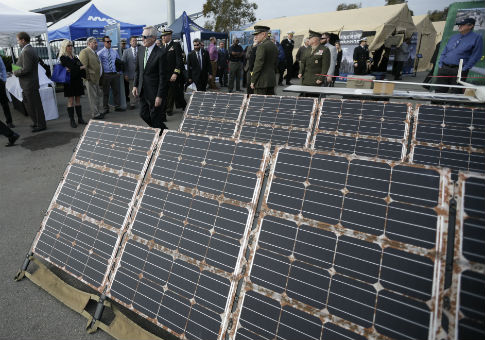The U.S. Navy handed out a $334 million contract for solar power without having a good way to determine whether the project would be cost effective.
The Pentagon’s inspector general recently audited three of the Navy’s large-scale renewable energy projects at installations supervised by the U.S. Pacific Command, finding that federal employees tasked with carrying out cost-effectiveness assessments of these projects did not have the documentation to back up their calculations or conclusions.
The Navy has not provided "comprehensive guidance" for evaluating the cost effectiveness of the six large-scale renewable energy projects in the region, according to the inspector general report issued last week. The Pentagon and the Navy also do not have a "formal written definition" of cost effectiveness for large-scale renewable energy projects.
Navy Secretary Ray Mabus made alternative energy a priority in 2009, directing the service to generate half of its total energy from alternative sources by 2020. In 2014, Mabus established an office to identify cost-effective projects for Navy installations to help achieve the service’s energy goals.
Measures to determine the cost savings of these projects have been unreliable due to shortcomings in the Navy’s guidance for evaluating the projects, according to the audit.
"Navy personnel could not support the assumptions and calculations made in their assessments because Navy guidance does not include specific steps for evaluating the cost-effectiveness of renewable energy projects and does not require that supporting documentation be maintained," the Pentagon inspector general wrote. "As a result, the Navy lacks assurance that cost-effectiveness assessments for its large-scale renewable energy projects are accurate, and that appropriate investments decisions are made."
Auditors identified this as an "internal control weakness" in the Navy’s process for evaluating renewable energy projects.
In one case, the Navy awarded a $334.1 million, 25-year contract for solar power at 14 military sites in Hawaii with inadequate procedures for determining that the project was cost effective. The company broke ground on the project in July 2014, but it has yet to generate solar power.
Navy personnel estimated that the project, called the Solar Multiple Award Contract, would generate between $62 million and $77 million in cost savings over the course of 25 years. The calculations were unsubstantiated, according to the report. Auditors also discovered that the contract does not have a requirement to reevaluate cost effectiveness once the project starts generating solar energy.
The Navy is still in lease negotiations for the other two large-scale renewable energy projects in the Pacific reviewed by the inspector general. The three major projects in the region that were not reviewed by the inspector general are in the development stage and have not undergone assessments for cost effectiveness.
"The Department of the Navy (DON) takes the Department of Defense Inspector General (IG) report seriously and acknowledges the opportunity to codify its best practices for assessing the cost effectiveness of large-scale renewable energy projects," said Lt. Chika Onyekanne, a Navy spokesman. "We are confident that all executed contracts and leases for financed renewable energy projects are cost effective. The DON pursues renewable energy projects that yield cost savings, guarantee price stability, facilitate improvements to the electrical grid, and reduce the nation’s fossil fuel dependence, contributing to long-term energy security."
Mabus unveiled a series of "aggressive" energy goals in 2009, which included increasing alternative energy use and reducing petroleum use in the commercial fleet. Mabus also mandated that the service take energy efficiency into account when awarding contracts for systems and buildings.
A key prong of the Navy’s alternative energy agenda has been the development of its "Great Green Fleet" of warships running on biofuels. Mabus insisted that the fleet, which deployed to the Pacific in January, would enable "better warfighting."
"When it comes to power, my focus has been about one thing and one thing only: better warfighting," Mabus said in January. "The Great Green Fleet shows how we are transforming our energy use to make us better warfighters, to go farther, stay longer, and deliver more firepower. In short, to enable us to provide the global presence that is our mission."
